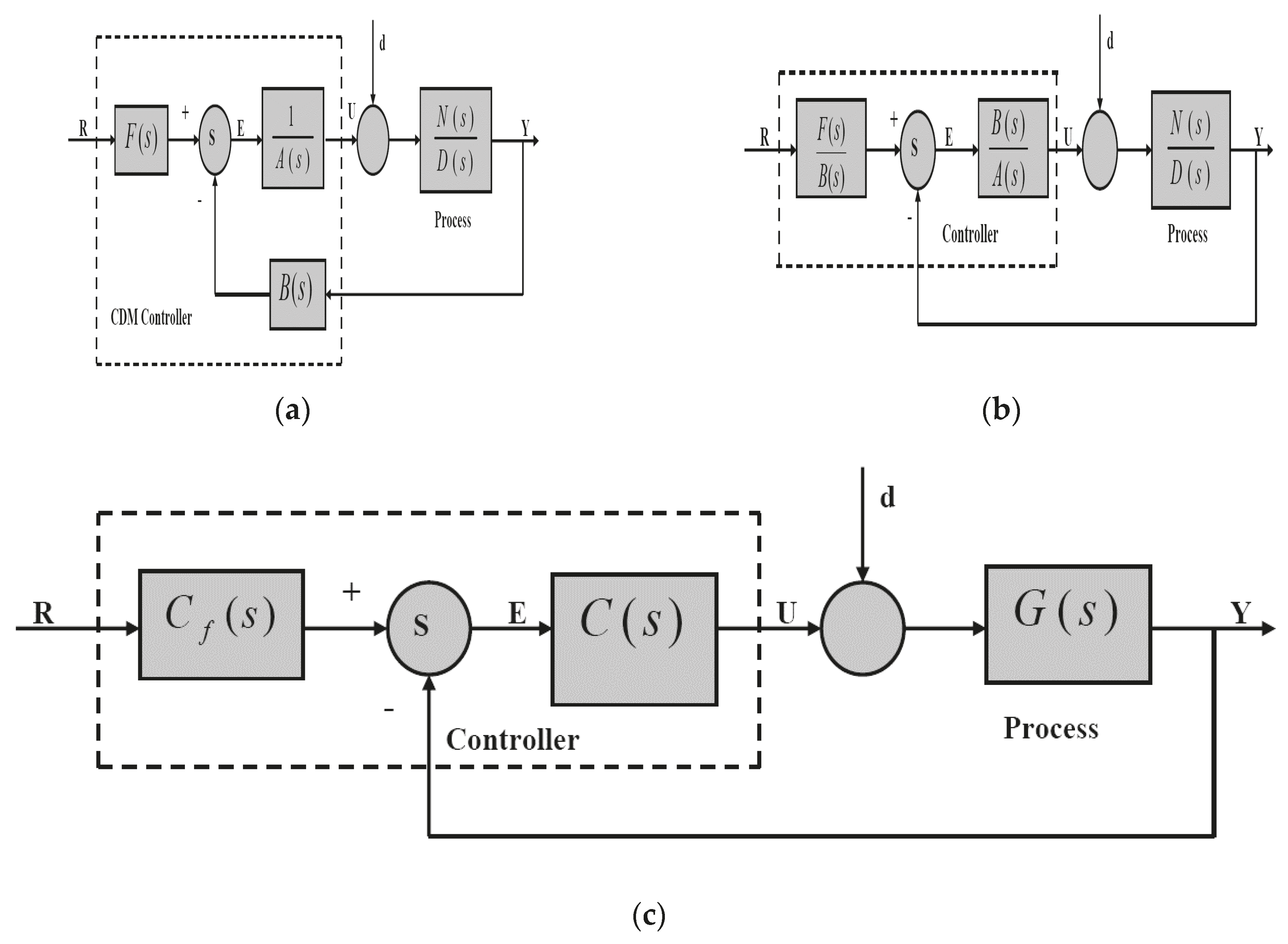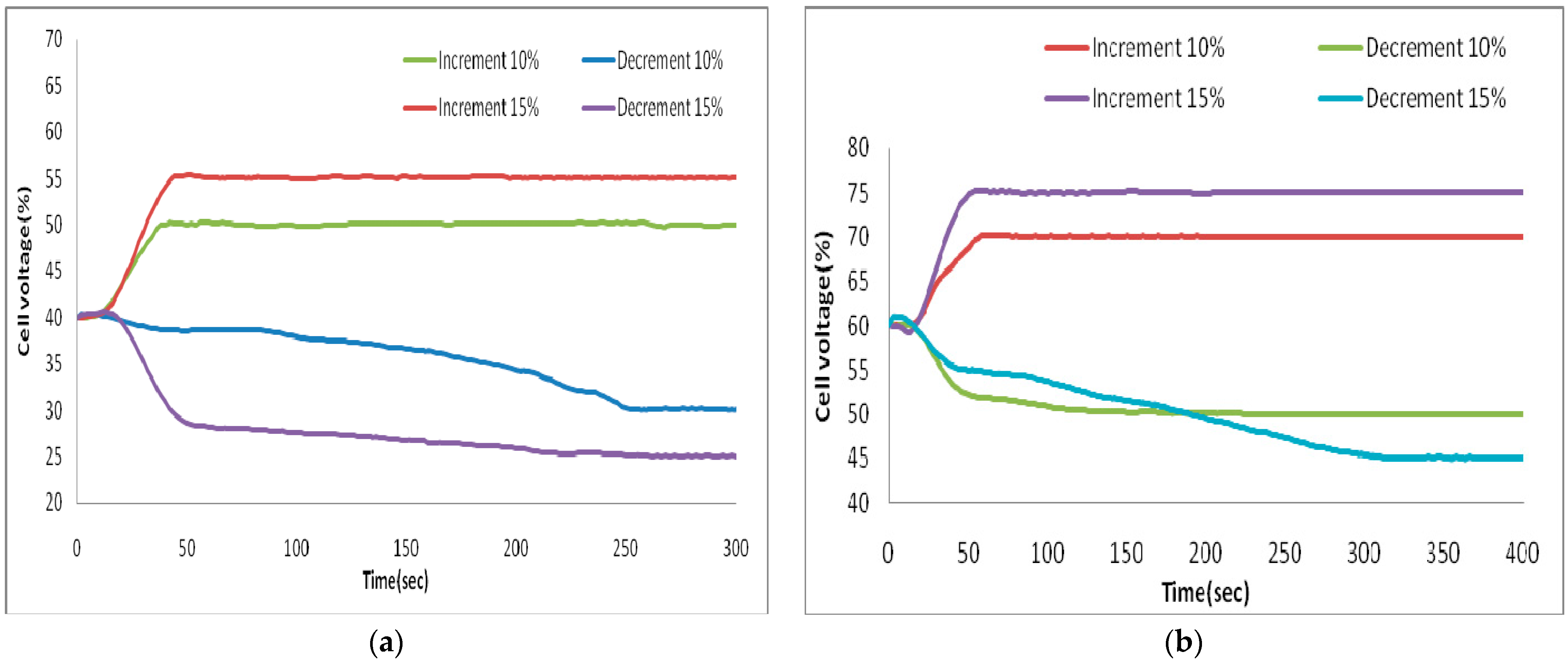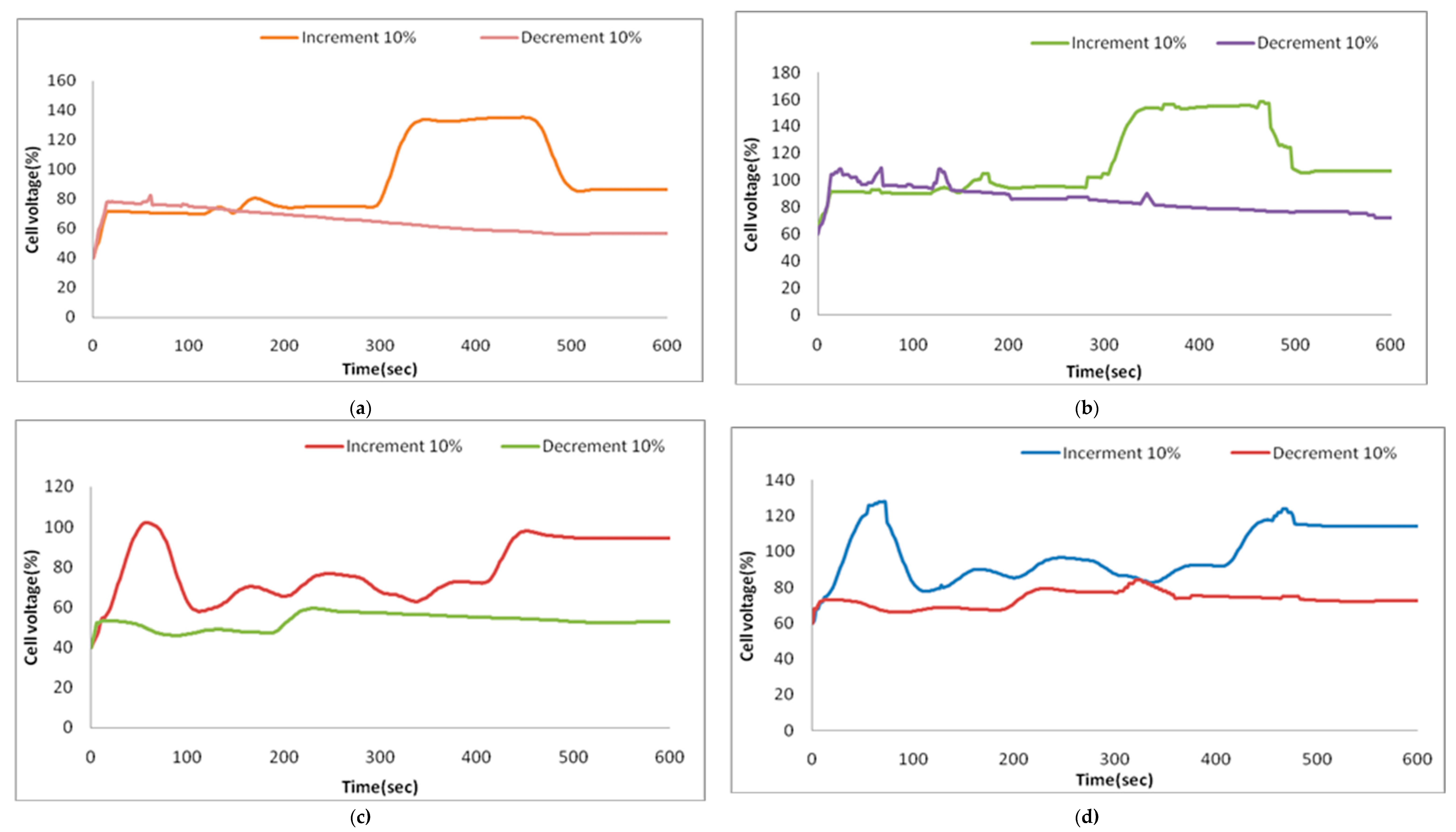Experimental Studies on a New Controller Design and Implementation in Direct Methanol Fuel Cell
Abstract
1. Introduction
2. Materials and Methods
2.1. State of the Art of DMFC Experimentation
2.2. Proposed Polynomial PI Controller
2.3. Design of Proposed Coefficient Diagram Based PI Controller
3. Results and Discussion
3.1. CD-PIC in DMFC
3.2. Conventional PIC in DMFC
4. Conclusions
Author Contributions
Funding
Acknowledgments
Conflicts of Interest
References
- Zenith, F.; Krewer, U. Modelling dynamics and control of a portable DMFC system. J. Process. Control. 2010, 20, 630–642. [Google Scholar] [CrossRef]
- Govindarasu, R.; Parthiban, R.; Bhaba, P.K. Experimental characterization of direct methanol fuel cell based on manifold design. Int. J. Appl. Chem. 2014, 10, 197–203. [Google Scholar]
- Manabe, S. The application of coefficient diagram method to ACC benchmark problem. In Proceedings of the 2nd Asian Control Conference, Seoul, Korea, 22–25 July 1997; pp. 135–138. [Google Scholar]
- Manabe, S. Coefficient diagram method. In Proceedings of the IFAC Symposium on Automatic Control in Aerospace, Seoul, Korea, 24–28 August 1998; pp. 211–222. [Google Scholar]
- Awouda, A.E.A.; Mamat, R.B. New PID tuning rule using ITAE criteria. Int. J. Eng. 2007, 3, 597–608. [Google Scholar]
- Padma, S.P.; Srinivas, M.N.; Chidambaram, M. A simple method of tuning PID controllers for stable and unstable FOPTD systems. Comput. Chem. Eng. 2004, 28, 2201–2218. [Google Scholar] [CrossRef]
- Sundmacher, K.; Scultz, T.; Zhou, S.; Scott, K.; Ginkel, M.; Gilles, E.D. Dynamics of the DMFC: Experiments and model-based analysis. Chem. Eng. Sci. 2001, 56, 333–441. [Google Scholar] [CrossRef]
- Govindarasu, R.; Parthiban, R.; Bhaba, P.K. Experimental studies on catalysts in direct methanol fuel cell. Elixir Int. J. Chem. Eng. 2014, 73, 26330–26332. [Google Scholar]
- Govindarasu, R.; Somasundaram, S. Studies on influence of cell temperature in direct methanol fuel cell operation. Process 2020, 8, 353. [Google Scholar] [CrossRef]
- Manabe, S. Brief tutorial and survey of Coefficient Diagram Method. In Proceedings of the 4th Asian Control Conference, Singapore, 25–27 September 2002; pp. 1161–1165. [Google Scholar]
- Imal, E. Design of CDM-based controller for integrating pumped tank process. J. Electr. Electron. Eng. 2009, 9, 1003–1013. [Google Scholar]
- Govindarasu, R.; Parthiban, R.; Bhaba, P.K. Coefficient diagram: A novel tool in polynomial controller design. Int. J. Chem. Sci. 2014, 12, 1645–1654. [Google Scholar]
- Bhaba, P.K.; Somasundram, S. Design and real time implementation of CDM-PI control system in a conical tank liquid level process. Sens. Transducer J. 2011, 133, 53–63. [Google Scholar]
- Argyropoulos, P.; Scott, K.; Taama, W.M. Dynamic response of the direct methanol fuel cell under variable load conditions. J. Power Sources 2000, 87, 153–161. [Google Scholar] [CrossRef]
- Krewer, U.; Sundmacher, K. Transfer function analysis of the dynamic behaviour of DMFCs: Response to step changes in cell current. J. Power Sources 2005, 154, 153–170. [Google Scholar] [CrossRef]
- Govindarasu, R.; Somasundaram, S.; Bhaba, P.K. Computer aided tool box for the design of CDM based PID family controllers. Taga J. Graph. Technol. 2018, 14, 1525–1537. [Google Scholar]
- Somasundaram, S.; Benjanarasuth, T. CDM-based two degree of freedom PI controller tuning rules for stable and unstable FOPTD processes and pure integrating processes with time delay. Int. J. Autom. Control. 2019, 13, 263–281. [Google Scholar] [CrossRef]
- Rinu, R.R.; Anand, L.D.V. Design and real time implementaion of a CDM-PI controller for a spherical tank level system. Int. J. Appl. Res. Mech. Eng. 2013, 2, 2319–3182. [Google Scholar]
- Janani, R.; Thirunavukkarasu, I.; Bhat, V.S. Experimental implementation of cdm based two mode controller for an interacting 2*2 distillation process. Int. J. Pure Appl. Math 2018, 118, 2241–2251. [Google Scholar]
- Meenakshipriya, B.; Saravanan, K.; Krishnamurthy, K.; Bhaba, P.K. Design and implimentation of a CDM-PI control strategy in a pH neutralization system. Asian J. Sci. Res. 2012, 5, 78–92. [Google Scholar] [CrossRef][Green Version]




| %Volt | ISE | IAE | Tr (s) | Trs (s) | %OS |
|---|---|---|---|---|---|
| (a) | |||||
| +10 | 2.7 | 22.9 | 42 | 42 | 0 |
| +15 | 4.5 | 56.7 | 40 | 40 | 0 |
| −10 | 3.3 | 25.2 | 250 | 250 | 0 |
| −15 | 1.75 | 58.87 | 256 | 256 | 0 |
| (b) | |||||
| +10 | 2.9 | 23.4 | 52 | 26 | 0 |
| +15 | 4.3 | 57.9 | 56 | 56 | 0 |
| −10 | 2.4 | 16.42 | 224 | 224 | 0 |
| −15 | 3.2 | 28.7 | 316 | 316 | 0 |
© 2020 by the authors. Licensee MDPI, Basel, Switzerland. This article is an open access article distributed under the terms and conditions of the Creative Commons Attribution (CC BY) license (http://creativecommons.org/licenses/by/4.0/).
Share and Cite
Govindarasu, R.; Somasundaram, S. Experimental Studies on a New Controller Design and Implementation in Direct Methanol Fuel Cell. Processes 2020, 8, 796. https://doi.org/10.3390/pr8070796
Govindarasu R, Somasundaram S. Experimental Studies on a New Controller Design and Implementation in Direct Methanol Fuel Cell. Processes. 2020; 8(7):796. https://doi.org/10.3390/pr8070796
Chicago/Turabian StyleGovindarasu, Ramasamy, and Solaiappan Somasundaram. 2020. "Experimental Studies on a New Controller Design and Implementation in Direct Methanol Fuel Cell" Processes 8, no. 7: 796. https://doi.org/10.3390/pr8070796
APA StyleGovindarasu, R., & Somasundaram, S. (2020). Experimental Studies on a New Controller Design and Implementation in Direct Methanol Fuel Cell. Processes, 8(7), 796. https://doi.org/10.3390/pr8070796





